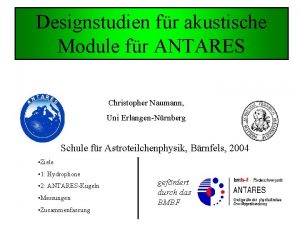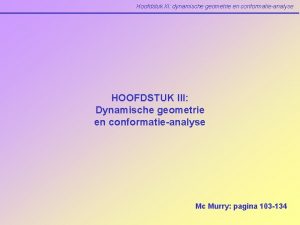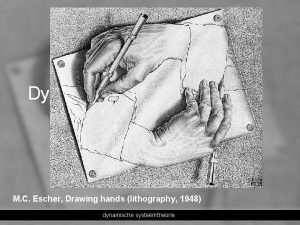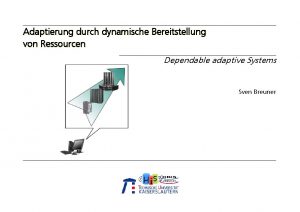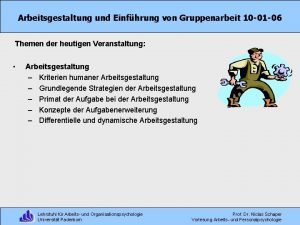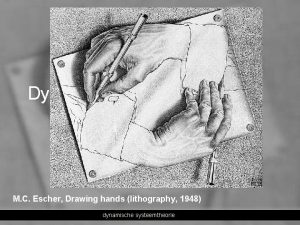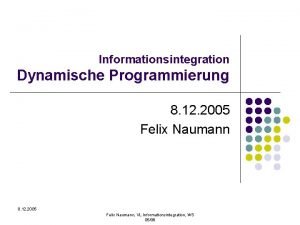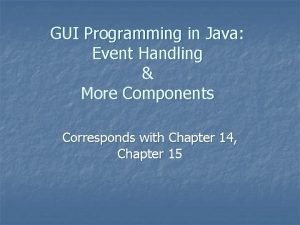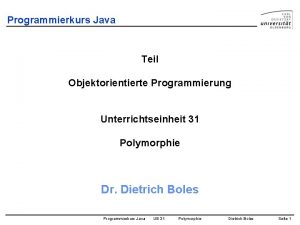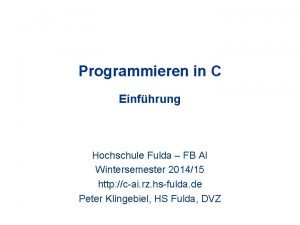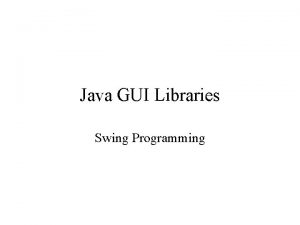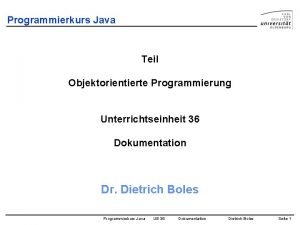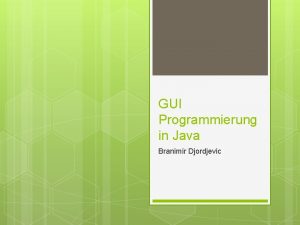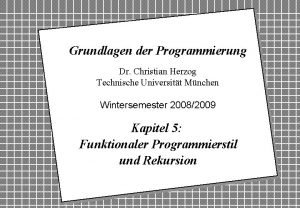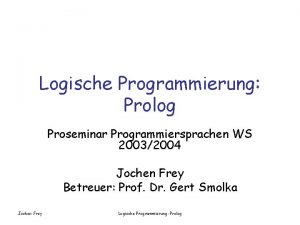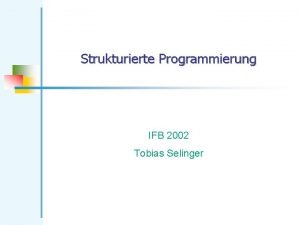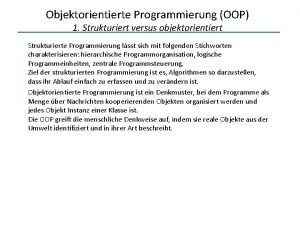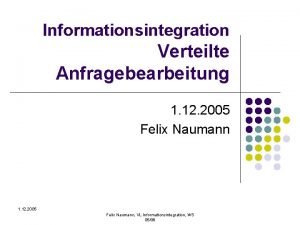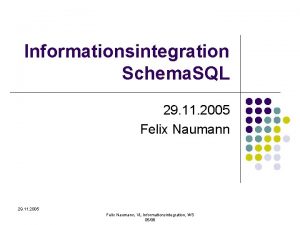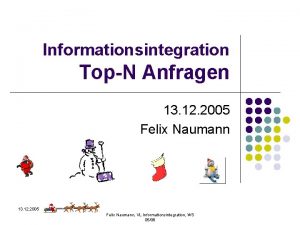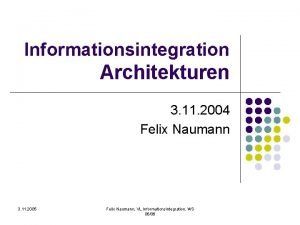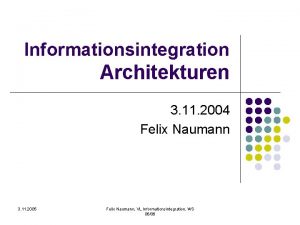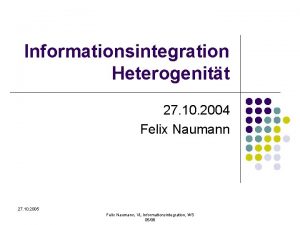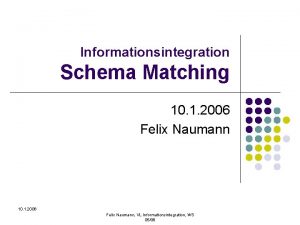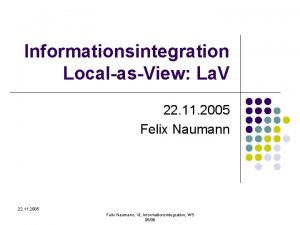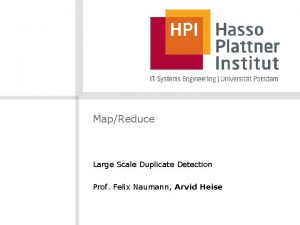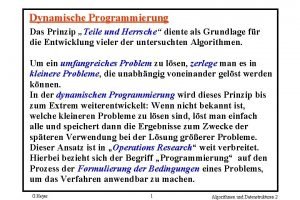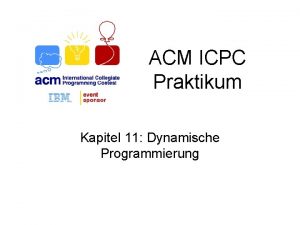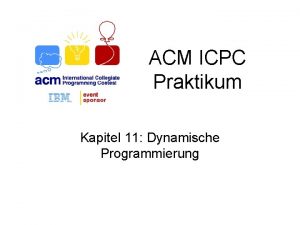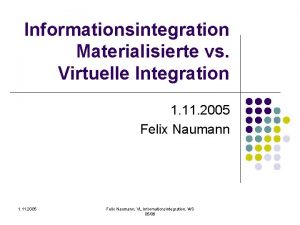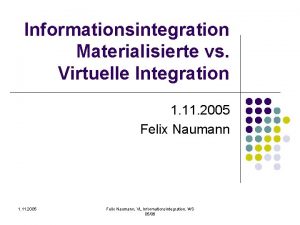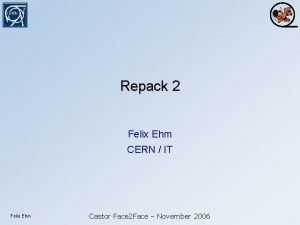Informationsintegration Dynamische Programmierung 8 12 2005 Felix Naumann






























![Literatur l Das grundlegende Paper l l Englisches Lehrbuch l l [SAC+79] Patricia G. Literatur l Das grundlegende Paper l l Englisches Lehrbuch l l [SAC+79] Patricia G.](https://slidetodoc.com/presentation_image_h/32cc05fe8c17c700b1a1411e485011db/image-31.jpg)
- Slides: 31

Informationsintegration Dynamische Programmierung 8. 12. 2005 Felix Naumann, VL Informationsintegration, WS 05/06

Überblick l Dynamische Programmierung (DP) zur Anfrageoptimierung l l Grundlagen der DP Das Grundproblem der Anfrageoptimierung DP für verteilte DBMS 8. 12. 2005 Felix Naumann, VL Informationsintegration, WS 05/06 2

Richard Bellman l l l 1920 – 1984 Ph. D Princeton (3 Monate) Los Alamos (1944 -1946) 1953 Rand Corporation: Erfindung der Dynamischen Programmierung Viele andere Beiträge zur Mathematik l Bellman-Ford Algorithmus 8. 12. 2005 Felix Naumann, VL Informationsintegration, WS 05/06 3

The Stagecoach story l some 150 years ago there was a salesman travelling west by stagecoach. . B E H A C F New York J I D San Francisco G Quelle: Folien Ioana Popescu http: //faculty. insead. edu/popescu/ioana/ 8. 12. 2005 Felix Naumann, VL Informationsintegration, WS 05/06 4

Versicherungskosten 2 A 4 7 B 4 6 C 4 H 3 2 6 F 4 4 3 D 1 E 1 5 G J 3 3 3 4 I 3 Frage: Welches ist der beste (billigste) Weg? Quelle: Folien Ioana Popescu http: //faculty. insead. edu/popescu/ioana/ 8. 12. 2005 Felix Naumann, VL Informationsintegration, WS 05/06 5

Billigster Weg – Greedy Suche 2 A 4 7 B 4 6 C E 4 H 3 2 6 F 4 4 3 D 1 J 3 4 I 3 1 5 Greedy: A-B-F-I-J = 13 G 3 3 Frage: Gibt es einen besseren Weg? Quelle: Folien Ioana Popescu http: //faculty. insead. edu/popescu/ioana/ 8. 12. 2005 Felix Naumann, VL Informationsintegration, WS 05/06 6

Billigster Weg – Vollständige Suche 2 A 4 7 B 4 6 C 4 H 3 2 6 F 4 4 3 D 5 G 3 J 3 3 1 Besser: A-D-F-I-J = 11 1 E 4 I 3 Anzahl der möglichen Wege: 3 x 2 = 18 Quelle: Folien Ioana Popescu http: //faculty. insead. edu/popescu/ioana/ 8. 12. 2005 Felix Naumann, VL Informationsintegration, WS 05/06 7

The Stagecoach Solution l Idee der Dynamischen Programmierung l l Voraussetzung: Prinzip der Optimalität l l Hier: “Rückwärtsberechnung” Teilplan eines optimalen Plans ist ebenfalls optimal Idee l l Ausgehend vom Zielknoten stufenweise rückwärts beste Teilpfade berechnen F(X) : = minimale Kosten von X nach J Quelle: Folien Ioana Popescu http: //faculty. insead. edu/popescu/ioana/ 8. 12. 2005 Felix Naumann, VL Informationsintegration, WS 05/06 8

Billigster Weg - DP F(B)=11 2 B A C F(C)=7 3 D F(D)=8 4 6 F(A)=11 4 7 F(E)=4 1 E F(H)=3 4 H 3 2 3 6 F 4 J 3 4 F(F)=7 4 I 3 1 5 G 3 F(G)=6 F(X) : = min Kosten von X nach J 8. 12. 2005 F(J)=0 Felix Naumann, VL Informationsintegration, WS 05/06 F(I)=4 Quelle: Folien Ioana Popescu http: //faculty. insead. edu/popescu/ioana/ 9

Dynamische Programmierung l l Optimaler Algorithmus „Schwierigkeiten“ l l Prinzip der Optimalität muss gelten. Aufteilung des Problems in Teilprobleme Aufwand kann exponentiell sein Klassische Anwendungen l l Knapsack Problem Traveling Salesman Problem Maschinenbelegung Transportproblem 8. 12. 2005 Felix Naumann, VL Informationsintegration, WS 05/06 10

Überblick l Dynamische Programmierung (DP) zur Anfrageoptimierung l l Grundlagen der DP Das Grundproblem der Anfrageoptimierung DP für verteilte DBMS 8. 12. 2005 Felix Naumann, VL Informationsintegration, WS 05/06 11

Architektur zur Anfragebearbeitung Logische Optimierung (unabhängig von System und Konfiguration): Entschachtelung, redundante Prädikate, . . . Anfrage Parser Anfrageumschreibung Katalog/ Metadaten Syntax und etwas Semantik Erzeugt Anfragegraph 8. 12. 2005 Anfrageoptimierung Wandelt Plan (Baum) in ausführbaren Plan (Code) um. Anfrageergebnis Code Generierung Anfragebearbeitung (Engine) Optimierung für System und Konfiguration: Indices, Joinreihenfolge, Selektion der Datenquelle Daten Schema, Statistik, Partitionierung, Lage der Daten, . . . Felix Naumann, VL Informationsintegration, WS 05/06 12

Anfrageoptimierung l Suchraum l l Kostenmodell l Alle gültigen Anfragepläne Join-Operator Netzwerkkosten Optimierungsproblem l Finde im Suchraum den kostenoptimalen Anfrageplan. 8. 12. 2005 Felix Naumann, VL Informationsintegration, WS 05/06 13

Anfrageplanung l Heuristische Einschränkung des Suchraums l Keine Kreuzprodukte Außer explizite Kreuzprodukte in der Anfrage l l l Prädikate so früh wie möglich Nur links-tiefe (left-deep) Bäume Bushy ⋈ ⋈ S 8. 12. 2005 T T R Pipelined Execution ⋈ ⋈ ⋈ U ⋈ Left-Deep ⋈ ⋈ R ⋈ Zig-Zag S U R Felix Naumann, VL Informationsintegration, WS 05/06 S T U 14

Überblick l Dynamische Programmierung (DP) zur Anfrageoptimierung l l Grundlagen der DP Das Grundproblem der Anfrageoptimierung DP für verteilte DBMS 8. 12. 2005 Felix Naumann, VL Informationsintegration, WS 05/06 15

Dynamische Programmierung: Optimierung im System-R l l A. k. a. “Selinger-style query optimization” l Der klassische Artikel zur Anfrageoptimierung: [SAC+79] l Ursprünglich im IBM System-R l Heutzutage weit verbreitet Grundidee: l Nur “Left-deep” Anfragebäume l l l Bottom-up Generierung von Anfrageplänen l l D. h. nur Joinreihenfolge interessant Innere und äußere Relation unberücksichtigt Dynamische Programmierung (DP) Zusätzlich: interesting orders (interessante Sortierungen) Zusätzlich: interesting sites (interessante Ausführungsorte) Literatur mit Beispiel: [GMUW 00] Quelle: u. a. Folien Prof. Chen Li 8. 12. 2005 Felix Naumann, VL Informationsintegration, WS 05/06 16

8. 12. 2005 Felix Naumann, VL Informationsintegration, WS 05/06 17

Bottom-up Anfrageplangenerierung l Grundannahme 1: Nach dem Join über k Relationen ist die Join-Methode die k+1 te Relation um hinzuzujoinen unabhängig von den vorigen Join-Methoden. l l Grundannahme 2: Jeder Teilplan eines optimalen Plans ist ebenfalls optimal. l l Joinmethoden: Nested Loops, Hashjoin, Sort-Merge Join usw. Entspricht dem Prinzip der Optimalität: Wenn sich zwei Pläne nur in einem Teilplan unterscheiden, so ist der Plan mit dem besseren Teilplan auch der bessere Gesamtplan Bottom-up Anfrageplangenerierung: l Berechne die optimalen Pläne für den Join über (jede Kombination von) k Relationen l l l 8. 12. 2005 Suboptimale Pläne werden verworfen Erweitere diese Pläne zu optimalen Plänen für k+1 Relationen. usw. bis k = n Felix Naumann, VL Informationsintegration, WS 05/06 18

Dynamische Programmierung {} {R} {S} {T} {U} {R S} {R T} {R U} {S T} {S U} {T U} {R S T} {R S U} {S T U} {R T U} {R S T U} 8. 12. 2005 Felix Naumann, VL Informationsintegration, WS 05/06 19

DP – Grundidee für Anfrageoptimierung l Für jede Kombination merke (in einer Hilfstabelle): l l Geschätzte Größe des Ergebnisses (Kardinalität) Geschätzte minimale Kosten l l l Hier zur Vereinfachung: Größe des Zwischenergebnisses Joinreihenfolge, diese Kosten verursacht (= optimaler Teilplan) Induktion über Anzahl der Relationen im Plan l N=1: Für jede Relation l l N=2: Für jedes Relationenpaar R, S l l l Kardinalität = |R| x |S| x sf Kosten = 0 Joinreihenfolge: kleinere Relation links Clou: R und S jeweils mit besten access-path N=3: Für jedes Tripel R, S, T l l Kardinalität = Kardinalität der Relation Kosten = 0 (zur Vereinfachung) Joinreihenfolge: n/a Clou: Nur bestes Relationenpaar aus dem Tripel wird um dritte Relation ergänzt . . . 8. 12. 2005 Felix Naumann, VL Informationsintegration, WS 05/06 20

DP – Beispiel S • Anfrage über Relationen R, S, T, U. • Vier Join-Bedingungen T Anfragegraph R U u. U. auch Index. Scan(. . . ) 8. 12. 2005 Felix Naumann, VL Informationsintegration, WS 05/06 21

DP – Beispiel X X Kreuzprodukte nicht berücksichtigen! 8. 12. 2005 Besser als z. B. S ⋈ (T ⋈ R) oder (R ⋈ S) ⋈ T Felix Naumann, VL Informationsintegration, WS 05/06 S T R U 22

DP – Beispiel S T Anfragegraph R Bisher unberücksichtigt: Wahl des Join-Algorithmus 8. 12. 2005 U Optimaler (leftdeep) Plan Felix Naumann, VL Informationsintegration, WS 05/06 23

8. 12. 2005 Felix Naumann, VL Informationsintegration, WS 05/06 24

DP - interesting orders (Interessante Sortierung) l l Wd. H. : Prinzip der Optimalität: Wenn sich zwei Pläne nur in einem Teilplan unterscheiden, so ist der Plan mit dem besseren Teilplan auch der bessere Gesamtplan. Gegenbeispiel: l l l R(A, B) ⋈ S(A, C) ⋈ T(A, D) Bester (lokaler) Plan für R ⋈ S: Hash-Join Best (globaler) Gesamtplan: l l l 1. Sort-merge Join über R und S 2. Sort-merge Join mit T Warum könnte dies so sein? l l Das Zwischenergebnis von R ⋈sort-merge. S ist nach Join-Attribut A sortiert. Dies ist eine interesting order, die später ausgenutzt werden kann: l l 8. 12. 2005 Spätere sort-merge Joins Gruppierung (GROUP BY) Sortierung (ORDER BY) Eindeutige Tupel (DISTINCT) Felix Naumann, VL Informationsintegration, WS 05/06 25

DP - interesting orders (Interessante Sortierung) Bei Auswahl des besten Teilplans: l Kostenvergleich genügt nicht. l Es gibt keine vollständige Ordnung der Teilpläne nach Kosten. Auch Sortierungen müssen berücksichtigt werden. l l Lösung: Für jede Kombination von Relationen, speichere mehrere Sortiervarianten: l 1. 2. l l Nach jeder Variante der beteiligten Teilpläne Die “leere” Sortierung DP Tabellen werden „breiter“. Merke außerdem Join- und Sortieroperationen, diese Sortierung erzeugen. 8. 12. 2005 Felix Naumann, VL Informationsintegration, WS 05/06 26

DP – Algorithmus Alle Zugriffspläne für jede Relation Schlechtere Zugriffspläne verwerfen Achtung: Nicht left-deep! Quelle: [Ko 00] 8. 12. 2005 Felix Naumann, VL Informationsintegration, WS 05/06 27

Überblick l Dynamische Programmierung (DP) zur Anfrageoptimierung l l Grundlagen der DP Das Grundproblem der Anfrageoptimierung DP für verteilte DBMS 8. 12. 2005 Felix Naumann, VL Informationsintegration, WS 05/06 28

DP in verteilten Systemen l Entscheidungen des Optimierers l Zugriffpfade auf Relationen l l l Joinreihenfolge Art der Join-Berechnung l l Table-scan, Index-scan Nested loops, sort-merge usw. Neu: Ort der Join-Berechnung l l 8. 12. 2005 Am Speicherort der inneren Relation / des Zwischenergebnisses Am Speicherort der äußere Relation / des Zwischenergebnisses Am Ort der Weiterverarbeitung Anderswo, z. B. Ort der schnellsten CPU Felix Naumann, VL Informationsintegration, WS 05/06 29

DP in verteilten Systemen Berücksichtigung (und Repräsentation) mehrerer Speicherorte ⇒ mehr Zugrifspläne Berücksichtigung (und Repräsentation) des Ausführungsortes des Joins ⇒ interesting order und interesting site ⇒ mehr Zugrifspläne Am Ende gegebenenfalls noch ship Operator anfügen. 8. 12. 2005 Felix Naumann, VL Informationsintegration, WS 05/06 30
![Literatur l Das grundlegende Paper l l Englisches Lehrbuch l l SAC79 Patricia G Literatur l Das grundlegende Paper l l Englisches Lehrbuch l l [SAC+79] Patricia G.](https://slidetodoc.com/presentation_image_h/32cc05fe8c17c700b1a1411e485011db/image-31.jpg)
Literatur l Das grundlegende Paper l l Englisches Lehrbuch l l [SAC+79] Patricia G. Selinger, Morton M. Astrahan, Donald D. Chamberlin, Raymond A. Lorie, Thomas G. Price: Access Path Selection in a Relational Database Management System. SIGMOD Conference 1979: 23 -34 [GMUW 00] Hector Garcia-Molina, Jeffrey D. Ullman, Jennifer Widom: Database System Implementation Prentice-Hall 2000 Weiteres l l [Ko 00] The State of the Art in Distributed Query Processing, Donald Kossmann, ACM Computing Surveys 32(4), pages 422 -469. (Link auf WWW) [OK 00] Kiyoshi Ono, Guy M. Lohman: Measuring the Complexity of Join Enumeration in Query Optimization. VLDB 1990: 314 -325 [HFLP 89] Laura M. Haas, Johann Christoph Freytag, Guy M. Lohman, Hamid Pirahesh: Extensible Query Processing in Starburst. SIGMOD Conference 1989: 377 -388 [Graefe 93] Goetz Graefe: Query Evaluation Techniques for Large Databases. ACM Comput. Surv. 25(2): 73 -170 (1993) 8. 12. 2005 Felix Naumann, VL Informationsintegration, WS 05/06 31
 Thomas naumann
Thomas naumann Ingrid naumann
Ingrid naumann Joe naumann
Joe naumann Christopher naumann
Christopher naumann Naumann reversion reaction
Naumann reversion reaction Buymouldsonline.nl comfort kunststof stoelvorm
Buymouldsonline.nl comfort kunststof stoelvorm Dynamische hyperinflatie beademing
Dynamische hyperinflatie beademing Driehoek school ouder kind
Driehoek school ouder kind Dynamische systeemtheorie voorbeeld
Dynamische systeemtheorie voorbeeld Dynamische visie
Dynamische visie Dynamische bereitstellung
Dynamische bereitstellung Motivierende arbeitsgestaltung beispiele
Motivierende arbeitsgestaltung beispiele Prozessarbeit dynamische prozesse
Prozessarbeit dynamische prozesse Dynamische instabilität aktin
Dynamische instabilität aktin Dynamische folien
Dynamische folien Dynamische systeemtheorie voorbeeld
Dynamische systeemtheorie voorbeeld Dynamische optimierung beispiel
Dynamische optimierung beispiel Awteventlistener
Awteventlistener Polymorphie programmierung
Polymorphie programmierung Hochschule fulda ai
Hochschule fulda ai Robo pro software
Robo pro software Java swing components library
Java swing components library Ereignisgesteuerte programmierung
Ereignisgesteuerte programmierung Programmdokumentation beispiel
Programmdokumentation beispiel Branimir djordjevic
Branimir djordjevic Programmierung
Programmierung Prolog programmierung
Prolog programmierung Strukturierte programmierung beispiel
Strukturierte programmierung beispiel Strukturierte programmierung vs objektorientierte
Strukturierte programmierung vs objektorientierte Calliope.cc
Calliope.cc Strukturierte programmierung
Strukturierte programmierung Gui programmierung java
Gui programmierung java



